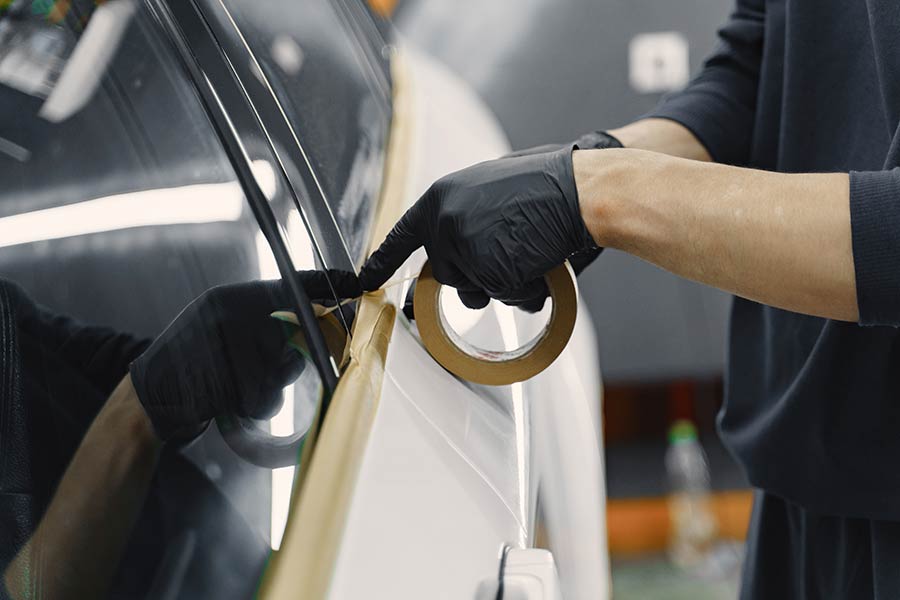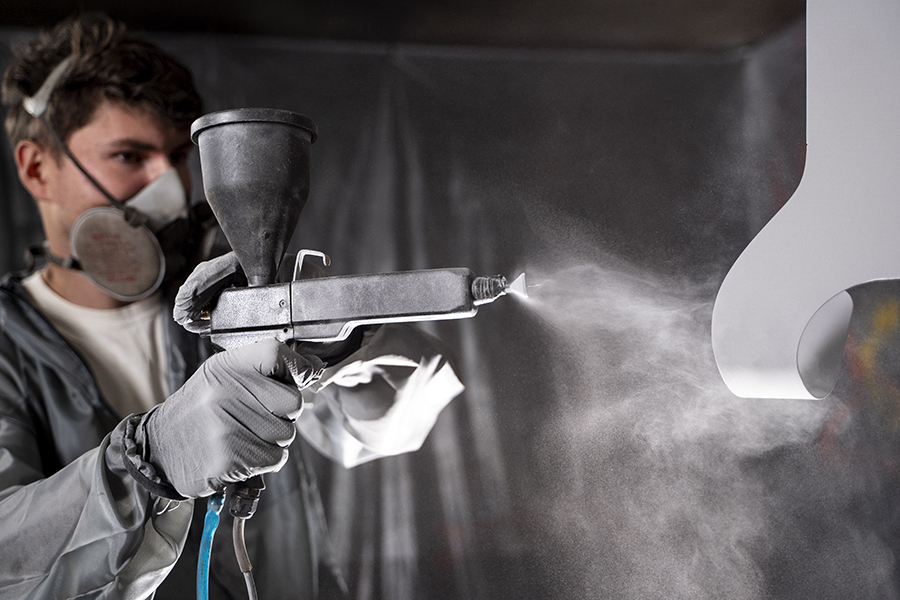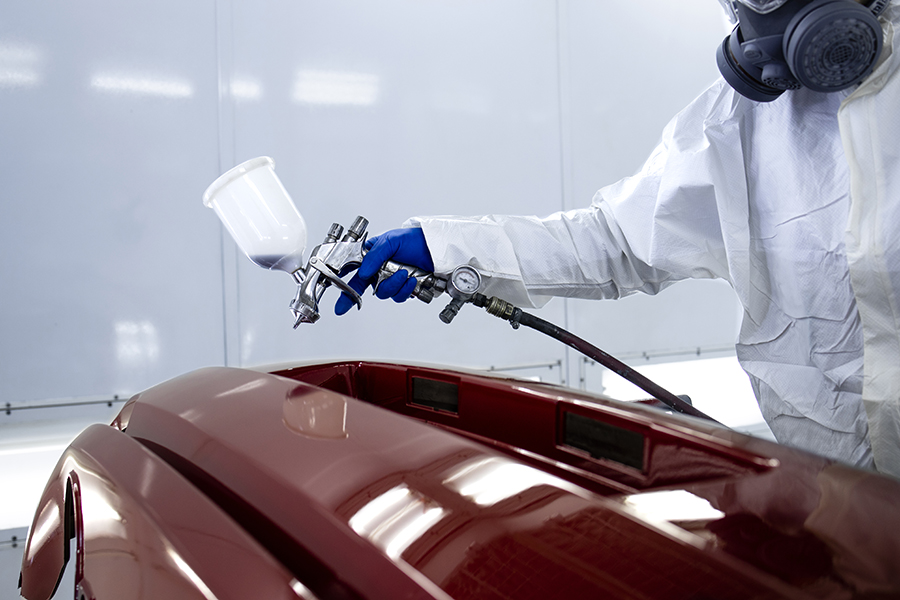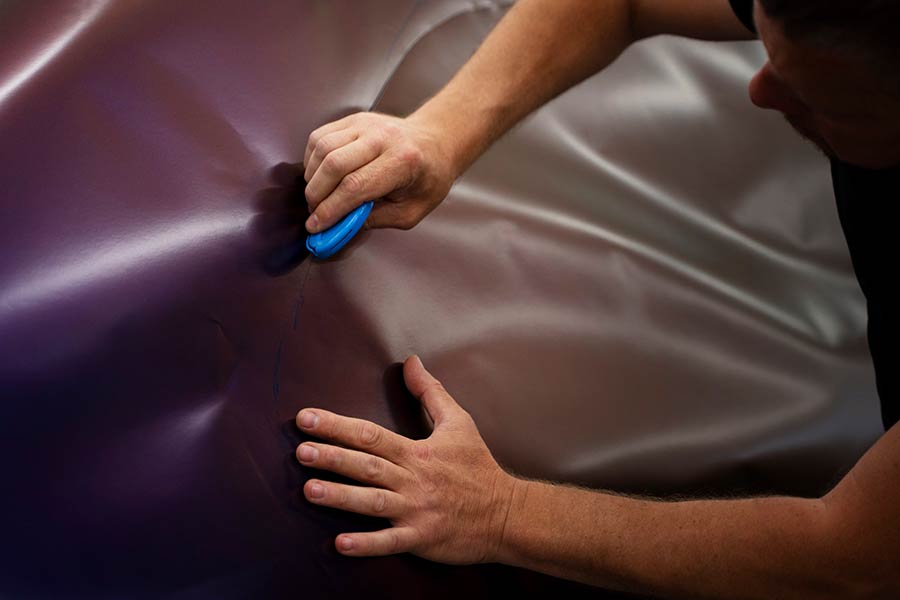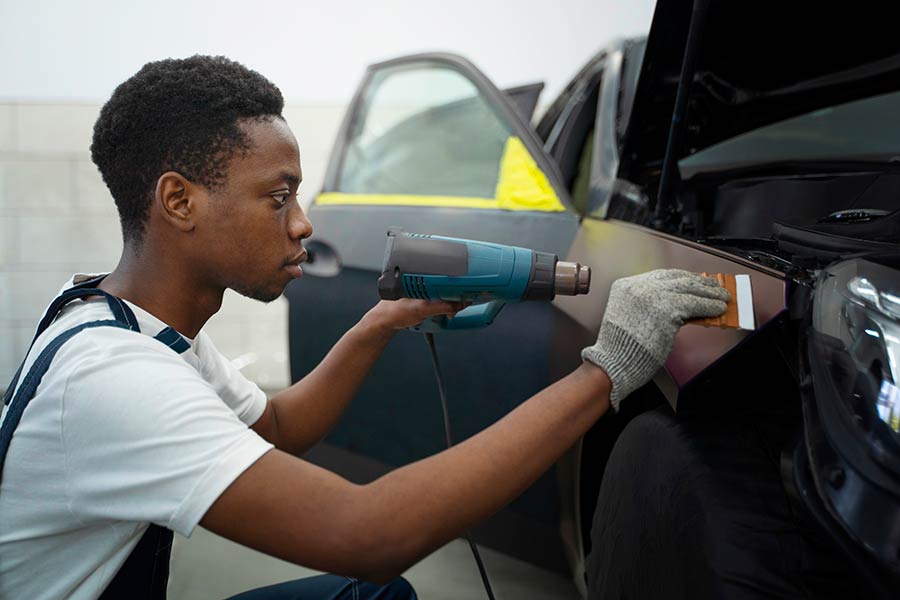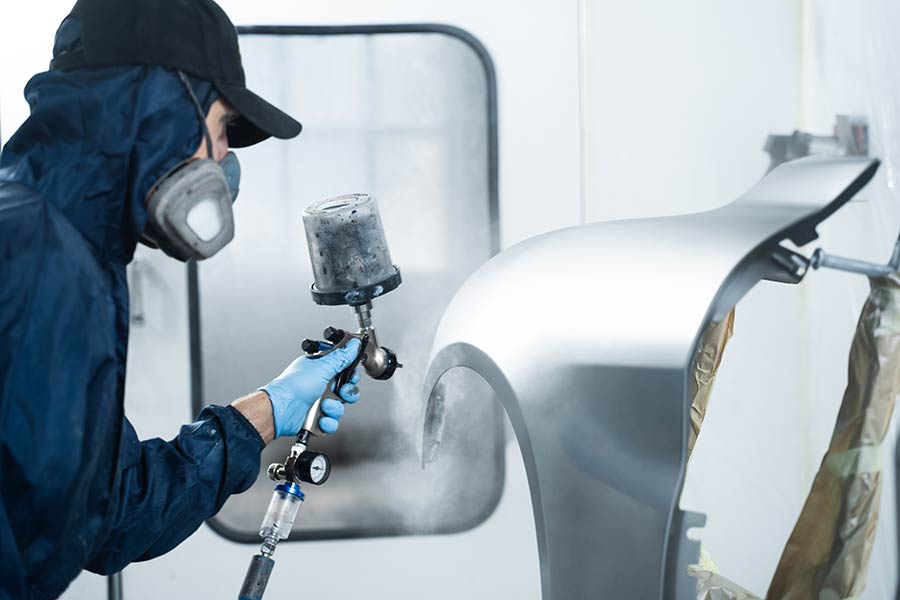Did you know that 52% of all cars on the road have some form of paint damage?
That heart-sinking moment when you spot a scratch on your car is something most vehicle owners know too well. Whether it’s from a shopping cart, a careless driver, or an unfortunate encounter with a bush, paint damage can turn your pristine vehicle into an eyesore.
We see these issues every day at our shop, and here’s what we’ve learned: most car owners wait too long to fix paint damage, turning a simple scratch auto paint repair into a costly problem. The good news? Modern technology and proper techniques can restore your car’s finish to its original glory.
From understanding paint layer structure to choosing the right repair method, this guide breaks down everything you need to know about fixing your car’s paint. We’ll walk you through our professional process, explain the costs, and show you how to protect your investment going forward.
Let’s start by looking at what’s really happening when your car’s paint gets damaged.
Paint Layer Structure
In my years of performing scratch auto paint repair, I’ve learned that understanding your car’s paint structure is like knowing the layers of your skin - each one serves a vital purpose. Modern automotive paint isn’t just one layer; it’s a sophisticated system of three main layers working together to protect and beautify your vehicle.
Clear Coat Layer Properties
The top layer of your car’s paint system is the clear coat, making up about 40% of the total paint thickness. This transparent guardian acts as your car’s first line of defense. My experience shows that a strong clear coat stops UV rays from fading your paint and shields against environmental threats like acid rain and bird droppings. Modern clear coats come with advanced hardness properties, making them more resistant to scratches and chemical damage.
Base Color Layer Composition
The middle layer - your base coat - brings your car’s personality to life. This layer holds all the color and visual effects that make your vehicle stand out. Through my work, I’ve handled three main types of base coats:
- Solid colors - straightforward, single-tone finishes
- Metallic finishes - containing aluminum flakes for sparkle
- Pearl finishes - using ceramic particles for color-shifting effects
Primer Layer Function
The primer is your paint system’s foundation. This first layer, typically 20-30 microns thick, does more than just stick to metal. It smooths out surface irregularities and creates an even canvas for the layers above. I’ve seen firsthand how good primer prevents rust formation and helps the base coat bond properly.
When dealing with paint damage, the depth of the scratch tells us which layer is affected. A surface scratch might only touch the clear coat, while deeper damage can reach the primer. That’s why professional assessment matters - each layer needs its own specific repair approach.
Paint Damage Assessment
As a professional paint specialist, I’ve seen how proper damage assessment can make the difference between a simple fix and a complete repaint job. Let me share my proven approach to evaluating paint damage that I’ve refined over years of hands-on experience.
Surface Scratch Analysis
When I examine a car’s surface, I start with proper lighting. I use specialized LED lights at different angles to spot even the finest scratches. Most surface-level damage shows up as light marring or swirl marks in the clear coat. I’ve found that running my hand over the surface can tell me a lot - if it feels rough like sandpaper, there’s likely bonded contamination that needs addressing before any repair work.
Deep Paint Damage Signs
Deep paint damage requires immediate attention. Here are the warning signs I look for: * White or gray lines that remain visible after cleaning * Paint that feels rough or raised around the scratch * Color variations or exposed metal in the damaged area * Paint checking (small cracks) around the damaged spot
Paint Thickness Testing
I rely heavily on electronic paint thickness testing in my work. These sophisticated tools tell me exactly how much clear coat remains, which is crucial for planning repairs. A typical factory finish measures between 4-7 mils (100-180 microns). When I find readings below this range, it signals potential problems.
My experience has taught me that removing more than 0.3 mils (8 microns) of clear coat during repair can risk UV damage to underlying layers. That’s why I take multiple measurements across each panel. This scientific approach helps me determine whether polishing is safe or if the panel needs more extensive work.
By following this systematic assessment process, I can spot problems that might go unnoticed and recommend the most effective repair strategy. This careful evaluation helps prevent costly mistakes and protects your investment in the long run.
Professional Repair Methods
Let me take you behind the scenes of our professional paint repair facility, where we transform damaged vehicles back to showroom condition. Our methods combine cutting-edge technology with time-tested techniques that I’ve mastered over decades in the industry.
Paint Matching Technology
I work with advanced spectrophotometers that read your car’s paint at multiple angles. These tools capture exact color data, measuring how light bounces off the surface to match even the most complex metallic and pearl finishes. When I scan your vehicle’s paint, the system analyzes thousands of color formulations to find the perfect match, making repairs virtually invisible.
Spray Application Process
The art of paint application demands precision and the right equipment. In my spray booth, I follow these proven steps:
- Mix paint with specific thinners based on temperature and humidity
- Apply primer in light, even coats (10 minutes per coat)
- Let each coat dry for 20 minutes
- Sand between coats with 2000-grit paper
- Apply color coats in smooth, side-to-side motions
- Finish with clear coat while previous layer is tacky
I hold my spray gun 6 inches from the surface, moving in steady sweeps. This technique prevents drips and creates that glass-like finish you expect.
Quality Control Steps
My quality checks start before the first drop of paint touches your car. I review repair orders thoroughly and complete detailed checklists for each stage. During painting, I check every coat under specialized lighting to spot any imperfections. After completion, I perform:
- Multiple paint thickness measurements across repaired areas
- Color matching verification under different light sources
- Road testing to confirm repair durability
I take pride in maintaining strict standards - each vehicle must pass five separate inspections before I consider the job complete. This attention to detail explains why my repairs blend seamlessly with factory finishes.
Modern Paint Protection
After performing countless scratch auto paint repair jobs, I’ve learned that prevention is better than cure. That’s why I recommend modern paint protection solutions to all my clients. Let me share what works best based on my hands-on experience.
Ceramic Coating Benefits
I apply ceramic coatings derived from quartz, one of Earth’s hardest substances. Once cured, this nano-ceramic technology creates an invisible shield that bonds with your car’s paint. My clients love these benefits:
- Remarkable water resistance that makes cleaning easier
- Strong defense against UV rays and chemical damage
- Superior gloss that lasts for years
- Protection from bird droppings and bug splatter
- Reduced need for regular waxing
Paint Protection Films
I’ve seen Paint Protection Film (PPF) stop rocks that would have chipped paint down to bare metal. Made from thermoplastic urethane, PPF acts as an invisible armor for your car. What makes me recommend PPF is its self-healing ability - when small scratches appear, the film repairs itself with just a bit of heat.
| Feature | Benefit |
|---|---|
| Self-healing | Repairs minor scratches automatically |
| Impact resistance | Protects against rock chips and debris |
| Longevity | Lasts 5-10 years with proper care |
| Clarity | Nearly invisible on your paint |
Maintenance Requirements
I tell my clients that maintaining these protective layers isn’t complicated, but it requires attention. For ceramic coatings, I recommend using pH-neutral car wash soap and microfiber cloths. Never use abrasive materials or harsh chemicals.
For PPF, regular cleaning prevents contaminant buildup. I suggest washing every 1-2 weeks with mild automotive detergent. The film’s self-healing properties work best when kept clean and occasionally exposed to warm sunlight or engine heat.
Both solutions work even better together. I often apply ceramic coating over PPF for my clients who want maximum protection. This combination creates a dual-layer defense system that keeps cars looking new for years while preventing the kind of damage that would need scratch auto paint repair.
Paint Repair Costs
Let me break down the real costs of paint repair, based on my extensive experience working with thousands of vehicles. Understanding these numbers will help you make smart decisions about your car’s maintenance.
Repair Type Price Ranges
I’ve seen paint repair costs vary significantly based on the damage type. Here’s what you can expect to pay:
| Repair Type | Price Range |
|---|---|
| Minor Scratches | $150 - $300 |
| Medium Damage | $400 - $800 |
| Major Repairs | $1,000 - $3,500 |
| Full Panel Repaint | $840 - $1,440 |
These prices include materials like primers, clear coats, and finishing work. I always tell my clients that quality materials make up about 40% of the total cost - they’re worth every penny for a lasting repair.
Insurance Coverage Facts
Through my work with insurance companies, I’ve learned the ins and outs of coverage. Here’s what matters most:
- Collision coverage pays for paint damage from accidents
- Comprehensive coverage handles non-accident damage like:
- Weather-related issues
- Vandalism
- Environmental damage
I’ve noticed that many clients don’t know their deductible must be met before insurance kicks in. For minor scratch auto paint repair, paying out of pocket often makes more sense than filing a claim.
Value Retention Impact
Based on my experience with resale values, paint condition dramatically affects your car’s worth. Poor paint can drop your car’s value by up to 30%. I’ve seen cars with faded paint lose 20% of their value, while those with major scratches face even steeper drops.
The good news? A professional paint job can help maintain your car’s value. I’ve worked with countless clients whose timely repairs helped them get top dollar at resale time. Quick action on paint damage stops the spread of problems like rust and corrosion, which can seriously hurt your car’s value.
Remember, paint repair isn’t just about looks - it’s about protecting your investment. When you factor in the long-term benefits, professional paint repair often pays for itself through better resale value and reduced future repair needs.
Conclusion
Paint damage affects most vehicles on the road, but proper repairs protect both your car’s appearance and value. My years of experience show that quick action on paint issues prevents bigger problems down the road. Professional repairs, using advanced color matching and precise application techniques, make damage disappear while maintaining your vehicle’s factory finish.
Modern protection options like ceramic coatings and PPF add extra defense against future damage. These solutions, combined with regular maintenance, keep your car looking showroom-new for years. Paint condition directly impacts resale value - well-maintained paint can save thousands at trade-in time.
Ready to fix that bothersome scratch or protect your car’s finish? Schedule Repair with our expert team today. We’ll assess the damage, match your paint perfectly, and restore your vehicle’s appearance. Remember, quality paint work isn’t just about looks - it’s about protecting one of your most valuable assets.
## FAQs
-
How many layers are there in a car’s paint system? A modern car’s paint system typically consists of three main layers: the clear coat (top layer), the base color layer (middle layer), and the primer layer (bottom layer). Each layer serves a specific purpose in protecting and beautifying the vehicle.
-
What is the function of the clear coat layer? The clear coat is the top layer of a car’s paint system, making up about 40% of the total paint thickness. It acts as the first line of defense, protecting against UV rays, environmental threats like acid rain and bird droppings, and providing resistance to scratches and chemical damage.
-
How do professionals assess paint damage on a car? Professional paint specialists use a combination of techniques to assess paint damage, including: - Using specialized LED lights at different angles to spot fine scratches - Feeling the surface for roughness or contamination - Looking for signs of deep damage like white or gray lines, exposed metal, or paint checking - Using electronic paint thickness testing tools to measure the remaining clear coat
-
What are some modern paint protection options for cars? Two popular modern paint protection options are:
- Ceramic coatings: These create an invisible shield bonded to the car’s paint, offering water resistance, UV protection, and a long-lasting glossy finish.
-
Paint Protection Films (PPF): These act as an invisible armor for the car, with self-healing properties for minor scratches and strong impact resistance.
-
How much does professional paint repair typically cost? Paint repair costs can vary widely depending on the extent of the damage: - Minor scratches: $150 - $300 - Medium damage: $400 - $800 - Major repairs: $1,000 - $3,500 - Full panel repaint: $840 - $1,440 These prices include materials and labor costs.
-
How does paint condition affect a car’s resale value? Paint condition significantly impacts a car’s resale value. Poor paint can decrease a car’s value by up to 30%, while faded paint can lead to a 20% drop in value. Maintaining good paint condition through timely repairs and protection can help retain the car’s value and potentially lead to better resale prices.
-
What are the benefits of ceramic coating for car paint? Ceramic coatings offer several benefits for car paint, including: - Exceptional water resistance for easier cleaning - Strong protection against UV rays and chemical damage - Long-lasting high gloss finish - Defense against bird droppings and bug splatter - Reduced need for regular waxing
-
How often should I wash my car if it has a ceramic coating or paint protection film? For cars with ceramic coatings, it’s recommended to wash every 1-2 weeks using a pH-neutral car wash soap and microfiber cloths. For paint protection films, regular cleaning (also every 1-2 weeks) with a mild automotive detergent is advised to prevent contaminant buildup and maintain the film’s self-healing properties.
